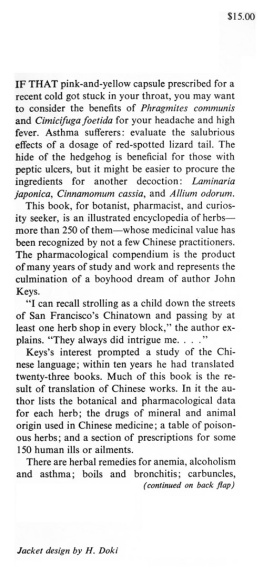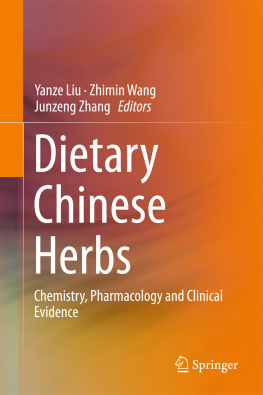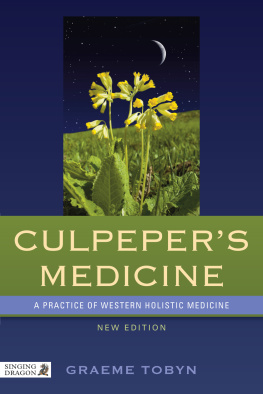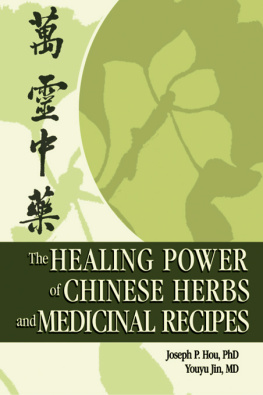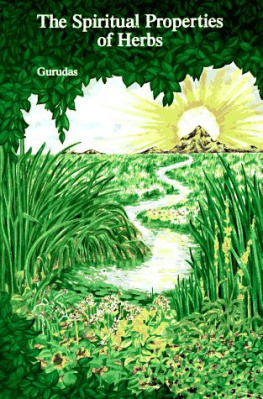All temperatures given are in degrees centigrade.
APPENDIX I.
SUPPLEMENTARY BOTANICAL DRUGS
The following comprises a list of additional plants used in Chinese materia medica , descriptions and analyses of which were insufficient for inclusion in the main section of this work.
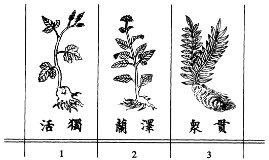
Angelica grosserrata Maxim. (Umbelliferae)
Root. Bitter, pungent; fragrant. Essential oil. Antispasmodic, analgesic, diaphoretic, diuretic. Dose, 4-11 gm.
Arethusa japonica A. Gr. (Compositae)
Leaves. Bittersweet. Essential oil, tannin. Diuretic, emmenagogue. Dose, 5-10 gm.
Aspidium falcatum Sw. (Polypod iaceae)
Root. Bitter. Slightly poisonous. Filicic acid, tannin, essential oil, starch, resin, sugar. Anthelmintic, hemostatic, antidote. Dose, 5-7 gm.
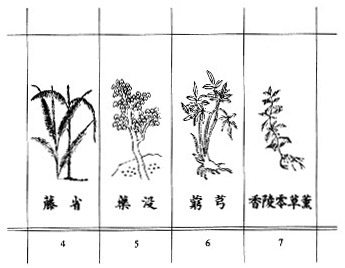
Calamus margaritae Hance. (Palmaceae)
Stem. Bitter. Anthelmintic, carminative, analgesic. Dose, 10-19 gm. Decoction used for toothache.
Commiphora myrrha Engler. (Burseraceae)
The resin. Bitter. 25-40% resin, 60% gum, 5% myrrhol; also yomniphoric acid, myrrholic acid, arabinose, oxydase, galactose, xylose. Exsiccant, stomachic, antispasmodic. Dose, 3-5 gm.
Conioselinum univittatum Turcz. (Umbelliferae)
Root. Bitter, very fragrant. 1-2% essential oil. Emmenagogue, sedative, analgesic. Dose, 4-11 gm.
Coumarouna odorata Aubl. (Leguminosae)
Stem and leaves. Bitter, pungent. Essential oil, coumarin. Aromatic stomachic, diaphoretic, antipyretic.
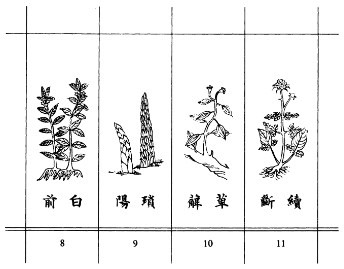
Cynanchum japonicum Moore et Decne. (Asclepiadaceae)
Root. Bitter, pungent. Antitussive, expectorant. Dose, 4-6 gm. (Syn. Vincetoxicum purpurascens Moore et Decne.)
Cynomorium coccineum L. (Balanophoraceae)
Stem. Sweet. Enzyme, fatty oil, sugar. Tonic, aphrodisiac, spermatopoietic. Dose, 4-11 gm.
Dioscorea sativa L. (Dioscoreaceae)
Root. Bitter. Dioscin, dioscoreasapotoxin. Alterative in syphilis, gonorrhea; diuretic. Dose, 5-10 gm.
Dipsacus asper Wall. (Dipsacaceae)
Root. Bitter, slightly pungent. Essential oil, alkaloid lamine. Tonic, analgesic, hemostatic. Dose, 5-10 gm.
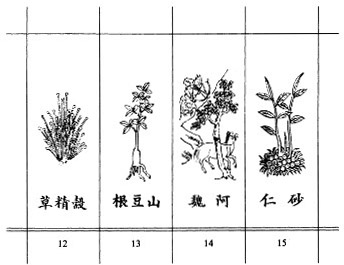
Eriocaulon sieboldianum Stend. (Eriocaulaceae)
Entire plant. Pungent, sweet. Antiphlogistic, ophthalmic. Dose, 5-10 gm.
Euchresta japonicum Benth. (Leguminosae)
Root. Bitter. Antipyretic, antiphlogistic, antidote. Dose 4-8 gm.
Ferula assafoetida L. (Umbelliferae)
The gum-resin. Bitter, pungent, fetid. 69% asaresinotannol, 4-6% sulfuretted volatile oil; also ferulic acid, vanillin, mucilage, bassorine. Vermicide, sedative, antispasmodic, digestive. Dose, 2-4 gm.
Hedychium coronarium Koen. (Zingiberaceae)
Seed. Pungent, aromatic. Essential oil (borneol, bornyl acetate, 1-camphor, linalool, nerolidol), carbohydrate 24%, fat 4%. Aromatic stomachic, carminative. Dose, 2-4 gm.
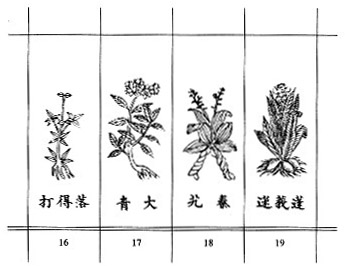
Inula helenium L. (Compositae)
Rhizome. Pungent, bitter, aromatic. Alantolactone (helenin), alantol (in fresh root only), inulin. Aromatic stomachic, anthelmintic, disinfectant and antiseptic, expectorant. Dose, 4-11 gm.
Isatis oblongata DC. (Crucifereae)
Fruit. Bitter, slightly saline. Isatin. Antiphlogistic, antipyretic, antidote. Dose, 7-15 gm.
Justicia gendarussa L. (Acanthaceae)
Root. Bitter, pungent. Alkaloid justicine, essential oil. Diuretic, antipyretic, sedative. Dose, 4-10 gm.
Kaempferia pandurata Roxb. (Zingiberaceae)
Tuber. Bitter, pungent. Essential oil (cineol, camphor, d-borneol, d-pinene, sesquiterpene, zingiberene), curcumin, zedoarin, resin, starch. Emmenagogue, aromatic stomachic, expectorant, analgesic. Dose, 2-7 gm.
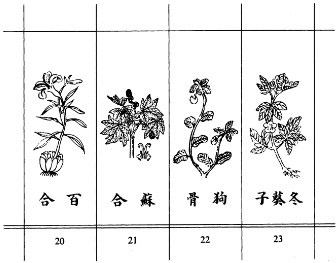
Lilium japonicum Thunb. (Liliaceae)
Bulb. Sweet, slightly bitter. 4% protein, 0.1 % fat, starch, colchiceine. Nutrient, antitussive, expectorant. Dose, 10-19 gm.
Liquidambar orientalis Mill. (Hamamelidaceae)
The resin. Pungent, sweet. Essential oil (styrol, vanillin, styrocamphor), balsam (cinnamic acid, cinnamein, styrocin, storesinol). Aromatic stimulant, expectorant. Dose, 1-2 gm. Externally for skin diseases, frostbite.
Mahonia japonica DC. (Berberidaceae)
Leaf and seed. Bitter. Nutrient tonic, antipyretic. Dose, 7-15 gm.
Malva verticillata L. (Malvaceae)
Seed. Sweet. 1% essential oil. Demulcent, diuretic. Dose, 8-15 gm. (Syn. M. chinensis Mill., M. pulchella Berhn.)
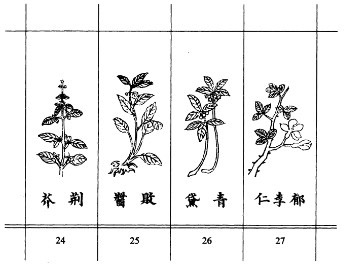
Nepeta japonica Maxim. (Labiatae)
Flowers and leaves. Pungent, slightly bitter, aromatic. 2% essential oil (menthone, limonene). Diaphoretic, antipyretic. Dose, 4-11 gm.
Patrinia scabiosaefolia Link. (Valerianaceae)
Root. Bitter, fetid. 8 % essential oil. Resolvent, antiphlogistic, diuretic. Dose, 8-15 gm.
Polygonum tinctorium Lour. (Polygonaceae)
Stem and leaves. Slightly saline. Indigotin. Antiphlogistic, antidote, antipyretic. Dose, 400-1,000 mg.
Prunus japonica Thunb. (Rosaceae)
Kernel of seed. Pungent, bitter, slightly sour. Diuretic, laxative. Dose, 4-7 gm. (Syn. P. glandulosa Thunb., P. sinensis Pers., P. chinensis Blume., P. domestica Thunb., Amygdalus pumila Sims., Cerasus japonica Loisel., C. dulosa Loisel.)
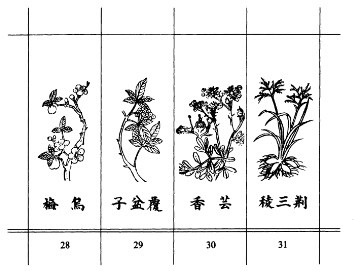
Prunus mume Sieb. et Zucc. (Rosaceae)
Unripe fruit. Sour, astringent. Hydrocyanic acid. Stomachic, antipyretic, astringent. Dose, 4-7 gm. (Syn. P. armeniaca Thunb., Armeniaca mume Sieb., A. nana Thunb.)
Rubus coreanus Miq. (Rosaceae)
Unripe seed. Sweet-sour, bitter. Tartaric acid, citric acid. Tonic, astringent. Dose, 5-10 gm. (Syn. R. tokkura Sieb.)
Ruta graveolens L. (Rutaceae)
Entire herb. Pungent, fragrant. 0.6% essential oil (80-90% methyl-n-nonyl ketone, methyl ketone, methyl-n-heptyl carbinol, nonyl carbinol, methyl acetate, pinene, cineol), rutin, flavonol. Antispasmodic, carminative, emmenagogue. Dose, 2-4 gm.
Scirpus maritimus L. (Cyperaceae)

